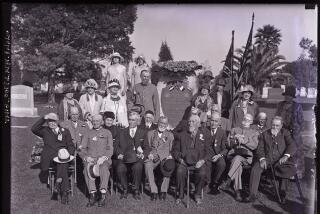Mormon Battalion’s Legacy Revived
SALT LAKE CITY — The Mormon Battalion trudged for six months over 1,500 miles of unforgiving deserts, mountains and rivers to claim California for the United States during its war with Mexico.
Starting from Council Bluffs, Iowa, on July 20, 1846, only 335 of the original 500 volunteers reached San Diego the next January, when the war was all but over.
Perhaps because its only real scrape was a dusty free-for-all with stampeding wild bulls along southern Arizona’s San Pedro River, the Mormon Battalion quickly passed into the realm of minor historical footnotes.
But the footsore ragtag’s march--one of the longest in the nation’s military history--was critical to securing America’s Western Empire. The battalion also blazed the main wagon road over the Sierra Nevada, opening the way for tens of thousands of settlers who would follow.
Unit members also participated in the discovery of gold at Sutter’s Mill and, by dutifully surrendering their wages ($7 a month for a private), were critical to the feeding and equipping of the Mormon exodus to the Salt Lake Valley in July 1847.
Among Mormons, the battalion’s memory has survived mostly as an inspirational object lesson told in Sunday school classes. But for Norma Baldwin Ricketts, that wasn’t enough.
Driven by curiosity, the former journalist spent 30 years retracing the unit’s steps and ferreting out old letters and dusty journals.
The result is a book, “The Mormon Battalion, U.S. Army of the West, 1846-48,” published by Utah State University Press, that Western historians are hailing as definitive.
But for Ricketts, who is 75 and a retired Sacramento newspaper drama and art critic, publication was only one of the rewards.
“I’ve come to feel like I really know some of these men,” she said. “It’s been such a joy when I’ve met some of their descendants . . . to be able to tell them what their man did, where he went.”
It was remarkable the tiny army ever came to be.
At first, the Mormons reacted with disbelief and anger when Capt. James Allen rode into their camp at Council Bluffs seeking volunteers.
After all, the same government represented by Allen’s uniform had refused to intervene in the 1830s when Missouri mobs drove them off their farms, or when the Mormons were chased from Illinois in the mid-1840s.
But the faithful fell in line when, after hearing Allen out, Mormon leader Brigham Young declared, “The thing is from above, for our own good.”
Young shrewdly hoped to curry favor with Washington, or at least defuse government hostility. And the battalion’s wages, more than $50,000 trickling back to the church’s general fund, would underwrite the exodus to the Great Basin.
In the early 1960s, while doing research on the Gold Rush, Ricketts stumbled on an oddity: Mormons in California two years before Young’s flock reached the Salt Lake Valley.
“Where did they come from? The Mormon Battalion. But I found there really hadn’t been anything written about the men,” she said. “Just dates and places and names didn’t do it for me. This battalion was just 500 nameless faces.”
That stirred Ricketts, who is proud of her own Mormon ancestors: Caleb Baldwin, a jail mate of Joseph Smith in Liberty, Mo., years before the church founder’s assassination in Carthage, Ill.; and Ralph Ramsay, who carved Salt Lake’s original Eagle Gate.
“We Mormons had the handcart migration stories, the sea gulls and crickets stories [the birds ate the insects, saving pioneer crops], but we really didn’t have the Mormon Battalion stories,” Ricketts said.
She began keeping index cards, first for a handful of men she had identified, and then adding to them as she pored over forgotten records and correspondence. When she moved to Mesa, Ariz., in 1988, Ricketts brought an archival mountain with her.
For the next nine years, she labored to reduce stacks of index cards and 16 file drawers stuffed with notes, clippings and biographies to a 400-page manuscript. Seven years were spent scribbling drafts on yellow legal pads, two more pecking on a secondhand computer.
Ricketts braced for a string of publishers’ rejections. The first to see it, though, snatched it up, and just two months after its modest release more than half the first run of 2,500 copies has been sold.
No one is more surprised than Ricketts. “I got into this as an amateur; I’m not a professional historian by any means,” she said.
No matter. She has earned the admiration of professionals.
“Ricketts has accomplished a marvel of research in her work,” said Kenneth N. Owens, Cal State Sacramento professor of American Western history. “Her volume will be a permanent addition to our literature and a vital reference work for all who follow.”
Brigham D. Madsen, University of Utah history professor emeritus, said the lack of an accurate, complete account of the battalion has, until now, been a gaping hole in the chronicles of the West.
Adds David L. Bigler, historical author and former Oregon-California Trails Assn. president: “We’ve lost sight today how significant it was that the U.S. claimed the entire Southwest. . . . The Mormon Battalion played a decisive role in that conquest.”
Ricketts is embarrassed by the praise for what essentially has been a labor of “longing that what I wrote would bring this battalion into our generation.”
“One of my dreams is to have people in the future telling battalion stories they read in my book to their children.”
One of those might be the story of Levi H. McCullough, a private in Company C.
After his July 16, 1847, discharge in Los Angeles, McCullough and other battalion members collected their $31.50 in wages, bought pack animals and supplies and began the long trek back to their loved ones.
But when they reached the Salt Lake Valley on Oct. 16, they found their families had not yet arrived. Ill-clothed, hungry and tired, they continued on, backtracking eastward.
The weather turned bitterly cold. They slogged through icy rivers, huddled together in blizzards and survived on the carcasses of their worn-out horses and mules.
Finally reaching Winter Quarters, Iowa, on Dec. 18, McCullough learned his wife and 2-year-old daughter had perished and his surviving children had been farmed out to other families.
The devastated McCullough and two traveling companions accepted a friend’s offer of food and shelter. Later that night, one of McCullough’s little sons was brought in.
Gazing in some confusion at the exhausted, dirty visitors in their tattered clothing, the boy finally asked: “Which one of these ragged men is my father?”
More to Read
Sign up for Essential California
The most important California stories and recommendations in your inbox every morning.
You may occasionally receive promotional content from the Los Angeles Times.










